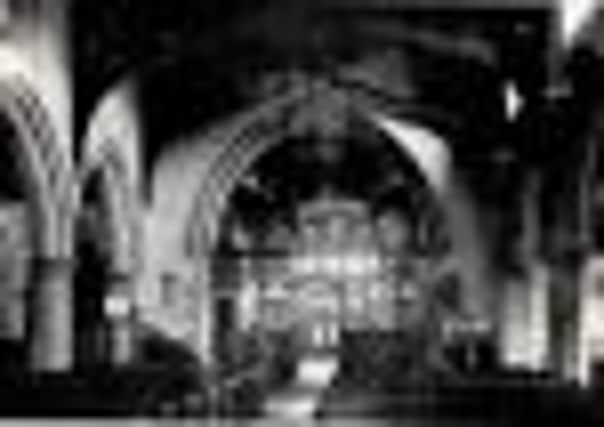Vicar built three churches and trained missionaries


Our forebears kept holy the Sabbath in the only way they knew how, on their knees in a church they had helped build.
Sadly many of these hallowed places have closed, and some have been demolished, never to be replaced, like those who built them.
Advertisement
Hide AdAdvertisement
Hide AdMen like the Rev John Buckworth, vicar of Dewsbury Parish Church for 30 years, who built three churches, St Paul’s Hanging Heaton, St Peters Earlsheaton, and St John’s Dewsbury Moor, all between 1823 and 1827.
The Rev Buckworth came to Dewsbury in 1806 and served here until his death in 1835, achieving more in Dewsbury than any other minister.
He was a mighty preacher, who started the first Sunday School in Yorkshire, enlarged the Dewsbury Parish Church, and trained missionary priests to spread the Word.
When he laid the foundation stone for St Paul’s, more than 7,000 people stood in Hanging Heaton to hear him preach.
Advertisement
Hide AdAdvertisement
Hide AdWorking so hard in the parish, and trying to procure new ministers to look after his newly-built churches, took a great toll on his health and almost certainly contributed to his early death in 1835 at the age of 56.
Throughout his ministry he was beset with great worries, none more so than the dreaded cholera outbreaks which ravaged the town from time to time which killed many people.
Another great concern to him was getting ministers to come to Dewsbury and serve in his newly-built churches, for a low stipend.
In a letter to a friend, he wrote: “I have been much occupied, and had many trying disappointments about procuring a minister for Hanging Heaton Church. For nearly six months, I have been on the eve of engaging ministers in succession, but as soon as the business has come to a point, they have declined the situation, solely on account of the smallness of the income, and I shall very shortly have Earlsheaton to provide for.”
Advertisement
Hide AdAdvertisement
Hide AdMr Buckworth, did eventually get ministers to take over the three churches, and, despite a succession of serious illnesses, he lived to see them flourish.
His death in 1835, cast a cloud over the town for many months to follow, and a monument to his memory was erected by parishioners in his beloved church, now renamed Dewsbury Minster Church.
Two of the churches he built, are still with us, St Paul’s and St John’s, but unfortunately, St Peter’s in Earlsheaton, had to be demolished because of subsidence, and was replaced by a parish centre just across the road.
OTHER churches in the town have not been so fortunate, like St Philip’s in Eastborough and St John the Baptist in Westtown, which were demolished during slum clearance when their members moved to other areas.
Advertisement
Hide AdAdvertisement
Hide AdOthers which closed, however, were saved from demolition and converted into community centres, or in the case of St Matthew’s in Westtown, into centres for the homeless.
Recently, I was delighted when a former member of the church, Jim Batty, showed me a booklet belonging to Alan Crabtree, giving the history of St Matthew’s.
The story of St Matthews started on December 2 1846 when the land on which it was to be built was bought for £351 from John Beaumont and his wife Susannah, of Daw Green.
The Vicar of Dewsbury at the time was the Rev Thomas Allbutt, who like his predecessor, John Buckworth, was keenly interested in building new churches, and he was able to raise the money to build St Matthew’s.
Advertisement
Hide AdAdvertisement
Hide AdThe census at that time showed there were 2,200 inhabitants, chiefly clothiers and labourers, living at a distance of a square mile from Dewsbury Parish Church, which wasn’t big enough to accommodate them.
The area the church was to serve included Daw Green and Fall Lane, the former being inhabited almost exclusively, according to the Census by ‘clothiers and beggars’.
Many people contributed towards its cost, the most generous being Mrs Hague, of Crow Nest, who gave £300, and local business leaders like the Wheatleys, Nowells, Wormalds, Cooks and Chadwicks.
In addition, two painted windows, carved woodwork and screen, a pulpit, lectern and Communion plate, were given by various individuals in the neighbourhood.
Advertisement
Hide AdAdvertisement
Hide AdThe whole cost was about £3,000, and very little was required to balance the account when the church was eventually consecrated.
THE foundation stone was laid at Whitsuntide 1847 by the Rev Allbutt.
Church records reveal that of the 566 burials in the churchyard over a period of 13 years, 370 of them were children and infants under the age of 14.
Gas lighting was installed in the church in 1873, but not without great resistance from the vicar at the time, the Rev Abbott, who was rather peculiar in his ways.
Advertisement
Hide AdAdvertisement
Hide AdHe fought against the introduction of gas lighting in the church for many years, describing it as an ‘institution of the devil to turn night into day’.
Despite all his idiosyncrasies, he did eventually relent, and was considered a good old soul, beloved by his parishioners for his graciousness and generosity to the poor.
This historic little booklet holds much more information about St Matthew’s, which I hope to refer to in later features, and perhaps former parishioners may have some photographs I might include in them.
• I am indebted to Imelda Marsden for the loan of her book Memoir of the Reverend J Buckworth, which provided me with details for this article.